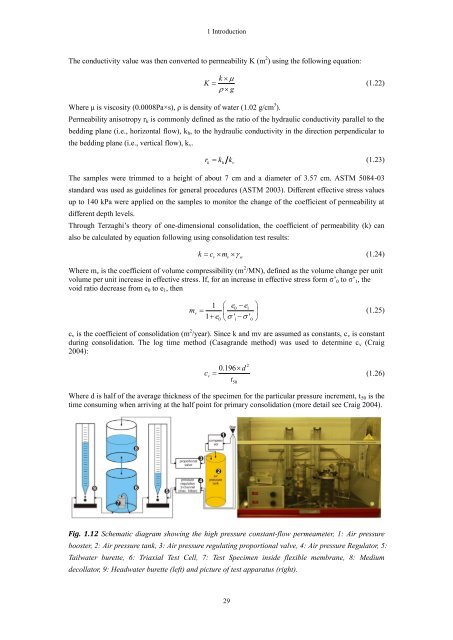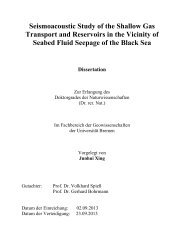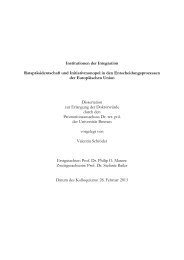Slope stability along active and passive continental margins ... - E-LIB
Slope stability along active and passive continental margins ... - E-LIB
Slope stability along active and passive continental margins ... - E-LIB
Create successful ePaper yourself
Turn your PDF publications into a flip-book with our unique Google optimized e-Paper software.
1 Introduction<br />
The conductivity value was then converted to permeability K (m 2 ) using the following equation:<br />
Where μ is viscosity (0.0008Pa×s), ρ is density of water (1.02 g/cm 3 ).<br />
k <br />
K (1.22)<br />
g<br />
Permeability anisotropy r k is commonly defined as the ratio of the hydraulic conductivity parallel to the<br />
bedding plane (i.e., horizontal flow), k h , to the hydraulic conductivity in the direction perpendicular to<br />
the bedding plane (i.e., vertical flow), k v .<br />
rk kh kv<br />
(1.23)<br />
The samples were trimmed to a height of about 7 cm <strong>and</strong> a diameter of 3.57 cm. ASTM 5084-03<br />
st<strong>and</strong>ard was used as guidelines for general procedures (ASTM 2003). Different effective stress values<br />
up to 140 kPa were applied on the samples to monitor the change of the coefficient of permeability at<br />
different depth levels.<br />
Through Terzaghi’s theory of one-dimensional consolidation, the coefficient of permeability (k) can<br />
also be calculated by equation following using consolidation test results:<br />
k cv mv <br />
w<br />
(1.24)<br />
Where m v is the coefficient of volume compressibility (m 2 /MN), defined as the volume change per unit<br />
volume per unit increase in effective stress. If, for an increase in effective stress form σ’ 0 to σ’ 1 , the<br />
void ratio decrease from e 0 to e 1 , then<br />
m<br />
1<br />
<br />
e<br />
e<br />
0 1<br />
v<br />
<br />
1 e0 '<br />
1<br />
'<br />
0<br />
<br />
<br />
<br />
(1.25)<br />
c v is the coefficient of consolidation (m 2 /year). Since k <strong>and</strong> mv are assumed as constants, c v is constant<br />
during consolidation. The log time method (Casagr<strong>and</strong>e method) was used to determine c v (Craig<br />
2004):<br />
2<br />
0.196<br />
d<br />
cv<br />
(1.26)<br />
t<br />
Where d is half of the average thickness of the specimen for the particular pressure increment, t 50 is the<br />
time consuming when arriving at the half point for primary consolidation (more detail see Craig 2004).<br />
50<br />
Fig. 1.12 Schematic diagram showing the high pressure constant-flow permeameter, 1: Air pressure<br />
booster, 2: Air pressure tank, 3: Air pressure regulating proportional valve, 4: Air pressure Regulator, 5:<br />
Tailwater burette, 6: Triaxial Test Cell, 7: Test Specimen inside flexible membrane, 8: Medium<br />
decollator, 9: Headwater burette (left) <strong>and</strong> picture of test apparatus (right).<br />
29
















